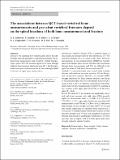The associations between QCT-based vertebral bone measurements and prevalent vertebral fractures depend on the spinal locations of both bone measurement and fracture
Author(s)
Demissie, S.; Anderson, D. E.; Allaire, B. T.; Kopperdahl, D. L.; Keaveny, T. M.; Kiel, D. P.; Bouxsein, M. L.; Bruno, Alexander Gregory; ... Show more Show less
Download198_2013_Article_2452.pdf (228.7Kb)
PUBLISHER_POLICY
Publisher Policy
Article is made available in accordance with the publisher's policy and may be subject to US copyright law. Please refer to the publisher's site for terms of use.
Terms of use
Metadata
Show full item recordAbstract
Summary
We examined how spinal location affects the relationships between quantitative computed tomography (QCT)-based bone measurements and prevalent vertebral fractures. Upper spine (T4–T10) fractures appear to be more strongly related to bone measures than lower spine (T11–L4) fractures, while lower spine measurements are at least as strongly related to fractures as upper spine measurements.
Introduction
Vertebral fracture (VF), a common injury in older adults, is most prevalent in the mid-thoracic (T7–T8) and thoracolumbar (T12–L1) areas of the spine. However, measurements of bone mineral density (BMD) are typically made in the lumbar spine. It is not clear how the associations between bone measurements and VFs are affected by the spinal locations of both bone measurements and VF.
Methods
A community-based case–control study includes 40 cases with moderate or severe prevalent VF and 80 age- and sex-matched controls. Measures of vertebral BMD, strength (estimated by finite element analysis), and factor of risk (load:strength ratio) were determined based on QCT scans at the L3 and T10 vertebrae. Associations were determined between bone measures and prevalent VF occurring at any location, in the upper spine (T4–T10), or in the lower spine (T11–L4).
Results
Prevalent VF at any location was significantly associated with bone measures, with odds ratios (ORs) generally higher for measurements made at L3 (ORs = 1.9–3.9) than at T10 (ORs = 1.5–2.4). Upper spine fracture was associated with these measures at both T10 and L3 (ORs = 1.9–8.2), while lower spine fracture was less strongly associated (ORs = 1.0–2.4) and only reached significance for volumetric BMD measures at L3.
Conclusions
Closer proximity between the locations of bone measures and prevalent VF does not strengthen associations between bone measures and fracture. Furthermore, VF etiology may vary by region, with VFs in the upper spine more strongly related to skeletal fragility.
Date issued
2013-08Department
Harvard University--MIT Division of Health Sciences and TechnologyJournal
Osteoporosis International
Publisher
Springer London
Citation
Anderson, D. E. et al. “The Associations between QCT-Based Vertebral Bone Measurements and Prevalent Vertebral Fractures Depend on the Spinal Locations of Both Bone Measurement and Fracture.” Osteoporosis International 25.2 (2014): 559–566.
Version: Author's final manuscript
ISSN
0937-941X
1433-2965